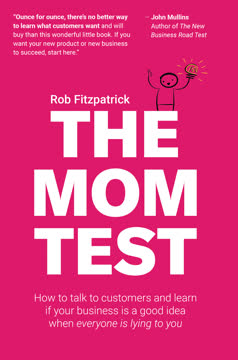Key Takeaways
1. Empowered product teams drive innovation and success
Great teams are made up of ordinary people who are inspired and empowered.
Empowerment unleashes potential. Empowered product teams are given problems to solve rather than features to build. They have the autonomy to make decisions and the responsibility to deliver results. This approach fosters innovation and allows companies to create products that customers love while meeting business needs.
Key elements of empowered teams:
- Cross-functional composition (product manager, designer, engineers)
- Ownership of a specific product area or customer problem
- Authority to make decisions about how to solve problems
- Accountability for outcomes, not just output
Empowered teams contrast sharply with feature teams, which are merely tasked with implementing pre-defined solutions. By trusting ordinary people with extraordinary responsibilities, companies can achieve remarkable results and outperform their competitors.
2. Strong product leadership is essential for empowerment
Leadership is about recognizing that there's a greatness in everyone, and your job is to create an environment where that greatness can emerge.
Leaders enable empowerment. Strong product leadership is the foundation for creating and sustaining empowered teams. Product leaders are responsible for providing strategic context, removing obstacles, and coaching team members to reach their full potential.
Key responsibilities of product leaders:
- Developing and communicating product vision and strategy
- Hiring and coaching product managers, designers, and engineers
- Managing stakeholder relationships and expectations
- Ensuring alignment between team objectives and company goals
- Advocating for resources and support from executives
Effective product leaders balance providing guidance with giving teams the space to innovate. They create an environment where failure is seen as a learning opportunity and where teams feel safe to take calculated risks.
3. Focus on competence and character when hiring
Trust is a function of two things: competence and character. Competence includes your capabilities, your skills, and your track record. Character includes your integrity, your motive, and your intent with people. Both are vital.
Hire for potential, not just experience. When building empowered product teams, it's crucial to focus on both competence and character. Competence ensures that team members have the necessary skills to succeed, while character ensures they will work well within the team and company culture.
Key hiring considerations:
- Technical skills and domain knowledge
- Problem-solving ability and critical thinking
- Collaboration and communication skills
- Integrity and alignment with company values
- Growth mindset and willingness to learn
Avoid the trap of hiring only for cultural fit, as this can lead to homogeneous teams. Instead, seek diversity in thought and experience to foster innovation. Remember that skills can be taught, but character is more difficult to change.
4. Effective coaching develops extraordinary teams
Coaching is no longer a specialty; you cannot be a good manager without being a good coach.
Continuous improvement through coaching. Effective coaching is the key to developing ordinary people into extraordinary teams. Managers must prioritize regular, one-on-one coaching sessions with their team members to help them grow and improve.
Essential elements of effective coaching:
- Weekly one-on-one meetings
- Active listening and asking probing questions
- Providing constructive feedback
- Setting clear expectations and goals
- Identifying and addressing skill gaps
- Celebrating successes and learning from failures
Coaching is not about micromanaging or giving orders. It's about helping team members develop their skills, overcome challenges, and reach their full potential. Good coaches create an environment of trust where team members feel safe to take risks and learn from their mistakes.
5. Product vision and strategy guide empowered teams
The product vision describes the future we are trying to create and, most important, how it improves the lives of our customers.
Align teams with a compelling vision. A clear product vision and strategy provide the necessary context for empowered teams to make good decisions. The vision describes the future state the company is working towards, while the strategy outlines how to achieve that vision.
Components of effective product vision and strategy:
- Long-term vision (3-10 years out)
- Customer-centric focus
- Alignment with industry trends and technologies
- Clear product principles to guide decision-making
- Focused strategy based on key insights
- Measurable objectives and key results (OKRs)
By providing this strategic context, product leaders enable teams to understand the bigger picture and make decisions that align with the company's goals. This empowers teams to innovate within a framework that ensures their efforts contribute to the overall success of the product and company.
6. Team topology impacts empowerment and innovation
A topology that results in too many dependencies can make this difficult.
Optimize team structure for autonomy. The way product teams are organized and structured, known as team topology, significantly impacts their ability to innovate and deliver results. A well-designed topology minimizes dependencies between teams and aligns with the product architecture and business objectives.
Considerations for effective team topology:
- Balance between platform and experience teams
- Clear ownership boundaries for each team
- Minimized dependencies between teams
- Alignment with product architecture
- Flexibility to evolve as the product and company grow
Avoid creating silos or teams that are too narrowly focused. Instead, strive for a topology that gives teams end-to-end responsibility for meaningful parts of the product. This enables true empowerment and accountability for outcomes.
7. Convert insights into action through team objectives
The product strategy is all about deciding which problems to work on.
From strategy to execution. Product strategy must be converted into actionable objectives for each product team. This process involves identifying the most important problems to solve based on customer insights and business goals, then assigning these problems to specific teams.
Steps to create effective team objectives:
- Focus on a small number of critical problems
- Leverage key insights from data and customer research
- Assign problems to teams based on their areas of ownership
- Allow teams to propose their own key results
- Ensure objectives are ambitious but achievable
- Regularly track progress and adjust as needed
By giving teams problems to solve rather than features to build, you empower them to find innovative solutions. This approach also ensures that teams are aligned with the overall product strategy and focused on delivering real value to customers and the business.
8. Collaborate with stakeholders as partners, not clients
Rather than the stakeholder being "the client" that tells us what to build, and as such needs to "be managed," now we have a partner that we need to help understand the constraints so we can discover a solution that works.
Build collaborative partnerships. In empowered product organizations, stakeholders are not clients to be managed but partners to collaborate with. This shift in mindset is crucial for creating products that meet both customer needs and business objectives.
Keys to effective stakeholder collaboration:
- Establish mutual trust and respect
- Share insights and learnings regularly
- Involve stakeholders in problem-solving discussions
- Communicate product strategy and vision clearly
- Address stakeholder concerns proactively
- Balance stakeholder needs with customer needs
By treating stakeholders as partners, product teams can leverage their expertise and insights while maintaining the autonomy to make product decisions. This collaborative approach leads to better solutions and stronger alignment across the organization.
9. Evangelize product vision and strategy continuously
Evangelism needs to be a constant.
Continuous communication is crucial. Product leaders must constantly evangelize the product vision and strategy throughout the organization. This ongoing communication ensures that everyone understands the direction of the product and their role in achieving it.
Effective evangelism techniques:
- Use prototypes to demonstrate ideas visually
- Share customer pain points and success stories
- Regularly update on progress and learnings
- Give credit generously to team members and stakeholders
- Show genuine enthusiasm for the product and vision
- Tailor communication to different audiences (executives, teams, partners)
Remember that evangelism is not a one-time event but an ongoing process. People need to hear the message multiple times and in different ways for it to truly sink in and inspire action.
10. Meaningful transformation requires leadership commitment
The prerequisite for this transformation is getting your senior leaders—typically starting with the CEO—to understand the necessary role of technology as the key enabler of the business, and not just a necessary cost of doing business.
Transformation starts at the top. Moving from feature teams to empowered product teams requires a significant shift in mindset and practices throughout the organization. This transformation can only succeed with full commitment from senior leadership.
Key steps for meaningful transformation:
- Secure buy-in from the CEO and executive team
- Establish strong product leadership
- Invest in hiring and developing the right talent
- Redefine relationships with stakeholders and business units
- Implement new processes and ways of working
- Continuously reinforce the new culture and mindset
Transformation is not easy or quick, but the benefits in terms of innovation, agility, and business results make it worthwhile. Leaders must be prepared to model the new behaviors and support the changes consistently over time.
Last updated:
FAQ
What's Empowered: Ordinary People, Extraordinary Products about?
- Focus on Product Teams: The book emphasizes the importance of empowered product teams in tech companies, highlighting their role in innovation and creating products that customers love.
- Role of Leadership: It discusses the critical role of strong product leadership in fostering an environment where teams can thrive and be accountable for their results.
- Empowerment and Autonomy: It advocates for a shift from traditional feature teams to empowered product teams that have ownership over the problems they solve.
Why should I read Empowered: Ordinary People, Extraordinary Products?
- Transformative Insights: The book offers practical advice and frameworks for building empowered product teams, leading to significant improvements in innovation and product success.
- Real-World Examples: It includes lessons learned from top tech companies, providing readers with relatable case studies and actionable strategies.
- Leadership Guidance: It provides guidance for product leaders on creating an environment that fosters empowerment and collaboration among teams.
What are the key takeaways of Empowered: Ordinary People, Extraordinary Products?
- Empowerment is Essential: Empowered product teams are crucial for innovation; they should be given problems to solve rather than just features to build.
- Strong Leadership Matters: Effective product leaders inspire and coach their teams, ensuring they have the strategic context needed to make informed decisions.
- Customer-Centric Approach: The book emphasizes the importance of understanding customer needs and integrating that understanding into product development.
What are the best quotes from Empowered: Ordinary People, Extraordinary Products and what do they mean?
- "Leadership is about recognizing that there's a greatness in everyone.": This quote underscores the role of leaders in creating an environment where team members can realize their potential.
- "If you think that by moving to Agile you've already done some form of digital transformation, I am sorry to tell you, but you haven't even gotten started.": This highlights that adopting Agile practices alone is insufficient for true transformation; a deeper cultural shift is necessary.
- "We need teams of missionaries, not teams of mercenaries.": This emphasizes the need for passionate, committed teams motivated by a shared vision rather than just completing tasks.
How does Empowered: Ordinary People, Extraordinary Products define strong product leadership?
- Inspiration and Execution: Strong product leadership involves inspiring teams while also ensuring effective execution of product strategies.
- Coaching Focus: Leaders are responsible for coaching their teams, helping them develop the necessary skills and knowledge to succeed.
- Strategic Context: Effective leaders provide their teams with the strategic context needed to make informed decisions and feel a sense of ownership over their work.
What is the role of technology in empowered product teams as discussed in Empowered: Ordinary People, Extraordinary Products?
- Core Business Enabler: The book argues that technology should be viewed as a core business enabler rather than a cost center, fundamentally changing how teams operate.
- Integration with Product Teams: Technology teams should work closely with product teams to ensure that the solutions developed are aligned with customer needs and business goals.
- Empowerment through Knowledge: Empowered teams leverage technology to solve customer problems creatively, requiring a deep understanding of both the technology and the market.
What is the significance of the coaching mindset in Empowered: Ordinary People, Extraordinary Products?
- Developing People: The coaching mindset emphasizes that developing team members is the primary responsibility of leaders, which leads to better outcomes for the organization.
- Building Trust: A strong coaching relationship fosters trust, allowing team members to feel safe in taking risks and sharing ideas.
- Continuous Improvement: The book advocates for ongoing coaching and feedback, which helps individuals and teams continuously improve their performance.
How does Empowered: Ordinary People, Extraordinary Products address the issue of stakeholder collaboration?
- Partnership Approach: The book emphasizes that product managers should view stakeholders as partners rather than clients, working collaboratively to find solutions that benefit both customers and the business.
- Understanding Constraints: Effective collaboration involves understanding the constraints and concerns of stakeholders, which helps in making informed decisions.
- Building Trust: Establishing a constructive relationship with stakeholders is crucial for gaining their support and ensuring successful product outcomes.
What is the importance of customer-centricity in Empowered: Ordinary People, Extraordinary Products?
- Understanding Customer Needs: The book stresses that product teams must prioritize understanding their customers to create products that truly meet their needs.
- Empathy in Product Development: Developing empathy for customers leads to better product decisions and innovations that resonate with users.
- Long-Term Success: A customer-centric approach is essential for long-term business success, as it fosters loyalty and satisfaction among users.
How does Empowered: Ordinary People, Extraordinary Products suggest handling performance reviews?
- Ongoing Feedback: The book argues that performance reviews should not be the primary feedback mechanism; instead, regular one-on-one meetings should be used for continuous feedback.
- No Surprises: Managers should ensure that there are no surprises during performance reviews, as ongoing discussions should have already addressed any issues.
- Focus on Development: The emphasis should be on developing team members rather than merely evaluating their past performance, fostering a culture of growth and improvement.
What are OKRs and how are they used in Empowered: Ordinary People, Extraordinary Products?
- Objectives and Key Results: OKRs are a framework for setting and communicating goals within an organization. They consist of specific objectives that teams aim to achieve and measurable key results that indicate progress.
- Empowerment Technique: Cagan argues that OKRs empower teams by allowing them to define their own key results based on the objectives set by leadership. This fosters a sense of ownership and accountability.
- Regular Check-Ins: The book emphasizes the importance of regular check-ins to track progress on OKRs. This ongoing management helps teams stay focused and adapt to any challenges that arise.
What challenges do organizations face when transitioning to empowered teams according to Empowered: Ordinary People, Extraordinary Products?
- Cultural Resistance: Organizations often face resistance to change from employees accustomed to traditional feature teams. Overcoming this resistance requires strong leadership and clear communication about the benefits of empowerment.
- Skill Gaps: There may be skill gaps in the existing workforce that need to be addressed to support empowered teams. Investing in training and development is crucial for building capable product teams.
- Alignment Issues: Ensuring alignment between product teams and other business units can be challenging. Effective collaboration and communication strategies are necessary to bridge these gaps.
Review Summary
EMPOWERED receives mostly positive reviews, with readers praising its insights on product leadership and empowered teams. Many find it valuable for understanding successful tech companies' practices. Critics note repetition from Cagan's previous book and lack of depth in some areas. The book is highly recommended for product managers, designers, and engineers, particularly those in leadership roles. Some readers found it too basic or lengthy, while others appreciated its practical advice and case studies. Overall, it's considered essential reading for product leaders in technology companies.
Similar Books










Download PDF
Download EPUB
.epub digital book format is ideal for reading ebooks on phones, tablets, and e-readers.






